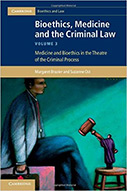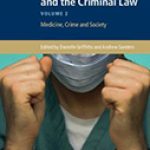Bioethics, Medicine and the Criminal Law, vol. 3: Medicine and Bioethics in the Theatre of the Criminal Process

Authors: Margaret Brazier and Suzanne Ost
Publisher: Cambridge, UK; New York: Cambridge University Press, 2013. 305p.
Reviewers: Joan H. Krause and Dan K. Moore | March 2014
Medicine and Bioethics in the Theatre of the Criminal Process is the third volume in the Bioethics, Medicine and the Criminal Law series. The book – a coauthored monograph rather than the essay collections of the first two volumes – is an ambitious project drawing from a variety of sources to illustrate the pervasive and yet unsatisfactory ways in which the criminal process is entangled in medical and bioethical disputes. Brazier and Ost frame these interactions through the lens of the “theatre,” highlighting the dramatic manner in which these stories unfold. From fifteenth century anatomy theatres to the modern media, legal battles over medical ethics loom large in literature and popular culture. Yet the presence of the theatre may obscure these disputes as easily as it illuminates, a phenomenon the authors analogize to “the moving beam of light emanating from a lighthouse” (10). The theatrical lens reminds us that these cases indeed are “performed” for a variety of audiences – prosecutors, judges, jurors, legislators, and laypersons – each of whom might construct a very different narrative of the rights and principles at stake.
The theatre is the key metaphor of the book: notably, the “transient connections” (10) it provides between criminal law and bioethics, and the distortions caused by the overly dramatic and highly public nature of these debates. Secondary themes include the extent to which a common grounding in political liberalism offers at least a partial connection between the disciplines, the effect of “moral sentiment” on these disputes, and the power of the medical profession to define the limits of proper medical care. Brazier and Ost incorporate a remarkable breadth of materials, including not only case law and statutory analysis but also history, philosophy, and medical ethics. Yet the sheer breadth of subject matter may at times be somewhat distracting; while the authors always return to the metaphor of the theatre, in some places it would have helped to have a tighter framework to link the chapters within each section. Moreover, while the authors’ use of the theatre often succeeds in illuminating the factors that make these disputes so complex, at times the metaphor seems forced.
Part I “set[s] the scene” (13) by highlighting the theatrical components of several famous cases to illustrate how the criminal process “intrudes” into medicine. The authors begin with a strikingly broad statement – “[t]he criminal law lays the foundation of the law governing most aspects of the practice of medicine” (15) – which they first support by tracing the development of the profession itself. While professional licensure largely has supplanted criminal law in regulating who can practice medicine, the authors note that in England the proceedings still retain something of a criminal flavor. The history of dissection (and medical involvement in body snatching) is offered as a second dramatic link to the criminal process. Finally, the authors present the cases of three doctors who were subject to high-profile prosecutions that illustrate the distorting aspects of the theatre: Aleck Bourne, who performed an abortion on a fourteen-year-old rape victim; Bodkin Adams, who administered a large amount of pain-relieving drugs to an elderly female patient; and Dr. Leonard Arthur, accused of withholding food and administering unnecessary drugs to a newborn with Down’s syndrome.
One lesson from these cases – the law’s deference to doctors’ views of appropriate care – is developed in the next chapter, which addresses the role of the medical profession in setting the boundaries of what individuals may do with their bodies. Medical privilege is evident even in the most basic surgery, where the doctor’s actions might in other circumstances constitute assault. The doctrine of informed consent does not alter this privilege, despite its emphasis on patient autonomy: while patient consent certainly is a prerequisite for surgery, patients do not have the power to force doctors to perform inappropriate procedures. Brazier and Ost convincingly argue that doctors define the line between prohibited self-injury and proper medical treatment, such as by distinguishing self-mutilation from permissible cosmetic surgeries. While the law may intervene to prevent certain behaviors that offend moral sentiment or cultural norms more broadly (such as the sale of organs), in most cases the medical profession sets the limits.
Situations where the doctor’s action results in death, however, whether from substandard care or an affirmative act of euthanasia or assisted suicide, may require a different analysis. Brazier and Ost argue that general homicide law is unsatisfactory in cases where the doctor’s behavior looks far different from that of the average criminal. This section focuses heavily on the United Kingdom, where a special subunit of the Crown Prosecution Service (CPS) has jurisdiction over the prosecution of “medical deaths.” Professional status once again is relevant to the criminal process, although it is unclear whether it weighs in favor of or against prosecution in such cases. The authors identify a strong moral argument for holding doctors accountable for deaths involving gross negligence; indeed, they argue for even broader criminal responsibility where the doctor breaches the obligation of beneficence, even if the patient (fortuitously) does not die. They are more troubled, however, when the doctor acts in the face of intractable societal disagreement, as in assisted suicide. Dissatisfied with the current ethical debate, which often rests on religious arguments regarding the “sanctity of life,” Brazier and Ost offer an alternative concept of “reverence for life” (89) as a multicultural universal value that might guide application of the criminal process to these disputes – an intriguing theory, but one that appears somewhat out of place in the broader theatrical analysis that frames the book.
Part II consists of a series of case studies exploring the judicial role in abortion, euthanasia and assisted suicide, and a famous case involving conjoined twins (Re A). Here, the court itself provides the theatre. While many of these disputes arise in civil rather than criminal court, Brazier and Ost argue that criminal concepts nonetheless pervade the judicial reasoning. Moreover, deference to the medical profession is common. Abortion remains illegal in the U.K., for example, yet the Abortion Act 1967 and subsequent case law permit the procedure if two doctors consider it to be proper medical treatment. Brazier and Ost conclude, “[s]o in the UK in practice, if not in law, the criminal process has ceded control of the termination of pregnancy to doctors” (96).
Doctors similarly are privileged in decisions at the end of life. In theory, motive is irrelevant to homicide crimes. Yet analysis of the doctor’s motivation pervades every stage of euthanasia and assisted suicide cases, from charging decisions (in which “wholly compassionate motivation” (128) is a factor) to jury verdicts to sentences, with the doctrine of double effect playing an important but implicit role. Brazier and Ost argue that sympathetic judges are able to use this reasoning to frame a narrative that favors the defendant; the authors, in contrast, would prefer that judges address these value judgments explicitly. Similar issues arise when patients ask to withdraw life-sustaining treatments, disputes that often are resolved through the moral fiction that death is caused by the underlying medical condition rather than the withdrawal of care. Brazier and Ost object to manipulating the criminal process to reach the “right” result in these cases, preferring instead to recognize an explicit defense for doctors. Yet they lament that the public theatrical nature of these disputes makes this unlikely: judges’ “starring role . . . means that their judgments will be scrutinized and dissected” (161) in a very public way, as may prosecutors’ charging decisions. The authors raise similar concerns regarding the conjoined twins case, noting that while the application for permission to surgically separate the twins arose under family law, the judges looked both to criminal law concepts (necessity) and bioethical analogies (withdrawal of life-sustaining care). Yet in the end no single theory proved satisfactory, suggesting that some medical disputes may lie beyond the ability of either law or ethics to resolve.
The most innovative and thought-provoking section of the book is Part III, in which the authors seek a common theoretical framework to link these criminal and bioethical “performances.” One promising connection is found in the disciplines’ shared heritage of political liberalism, which seeks to identify a core set of common principles to form consensus within a heterogeneous community. While this helps to explain the U.K. compromise on abortion, for example, it may fall short on issues when no consensus is possible. The concept of personal responsibility provides further parallels, although the comparison weakens to the extent that bioethics may hold doctors to a higher standard than the criminal law. Brazier and Ost elaborate on the relevance of theatrical interpretation to these often-political discussions, noting that too often there is no singular truth but only competing narratives.
In the final sections, Brazier and Ost explore the commonalities between the core bioethical principles (nonmaleficence, beneficence, autonomy, and justice), themselves grounded in liberalism, and the core criminal law principles (harm, welfare, and autonomy). While the principles are broadly compatible, they are not coextensive: the authors note that the general harm principle may be broader than the precept that doctors should “do no harm,” for example, and criminal law falls short of demanding that everyone act beneficently to further the good of others. Even autonomy is cast differently, serving as a limiting principle for criminality yet an affirmative ethical obligation for doctors. Brazier and Ost acknowledge that the disciplines diverge, in part, because they serve different functions in society: bioethics governs the doctor’s discharge of professional duties, while the criminal law must define strict rules that apply to all. The distortions of the theatre exacerbate these differences, particularly in cases involving deep moral sentiment, cultural differences, and political maneuvering. While skeptical that these disconnects can be “repaired,” the authors call for a more open dialogue about the role of medicalization and whether a special medical defense is warranted.
Although the authors focus on the United Kingdom, the volume is accessible to readers from the United States as well. Readers may not recognize the classic English medical ethics cases, but the subject matter will be familiar. The differences in statutory and regulatory control over the practice of medicine, however, may be more problematic. The United States has no equivalent to the Abortion Act 1967, nor a unitary CPS with discretion to prosecute a doctor for a patient’s death. The decentralized and largely state-based nature of medical and criminal oversight in the U.S. is distinct enough to raise questions about how well this framework fits. Perhaps related to this concern, as a U.S. health care lawyer I am not wholly convinced that the disconnections between medical ethics and the criminal process are quite as intractable as Brazier and Ost attest. Rather, we might ask why the two disciplines should be expected to be consistent. While a world in which the law criminalized standard medical practice would be untenable, that is not the case with most of the contentious and highly theatrical disputes highlighted in this volume – about which there may be little agreement even among medical professionals. Criminal law is indeed a powerful means for setting the boundaries of acceptable behavior, but demanding that it satisfactorily resolve debates about which both society and the medical profession itself are divided may simply expect too much.
Moreover, at least in the United States, doctors are far more likely to encounter the civil and administrative aspects of the legal system than the criminal ones, and health care lawyers are far more likely to grapple with criminal penalties for regulatory offenses such as billing fraud than for homicide. Perhaps the move of medical practice oversight from the criminal to the civil and administrative spheres reflects a rational recognition that the broad criminal process is not an appropriate forum for these disputes, rather than proof of an inherent philosophical incompatibility. In sum, while perhaps overstating their argument, Brazier and Ost nevertheless have produced a thought-provoking, well-researched volume that demands serious reflection about the proper relationship between medical practice, medical ethics, and the criminal law. It is well worth the read.
Joan H. Krause, Associate Dean for Faculty Development, University of North Carolina, Chapel Hill School of Law
Dan K. Moore, Distinguished Professor of Law, University of North Carolina, Chapel Hill School of Law


